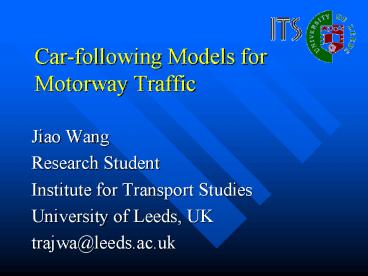Carfollowing Models for Motorway Traffic PowerPoint PPT Presentation
1 / 20
Title: Carfollowing Models for Motorway Traffic
1
Car-following Models for Motorway Traffic
- Jiao Wang
- Research Student
- Institute for Transport Studies
- University of Leeds, UK
- trajwa_at_leeds.ac.uk
2
Contents
- Introduction
- Development of the model
- Theoretical explanations
- Experiment design
- Simulation tests
- Conclusions
3
Introduction
- Car-following models
- Psycho-physical models (e.g. GM models)
- Safety-distance models (e.g. Gipps model)
- Action-points models ( Leutzbach and Wiedemann,
1986) - Motorway traffic flow characteristics
- - Traffic breakdown, shockwaves
- - Traffic hysteresis
4
Flow-Occupancy Diagram near Toronto (Hall et al.
1986)
- - Traffic hysteresis
- - Closing following (high flow, high speed)
5
The Development of the Model
Combination of safety-distance model and
close-following model with different reaction
times applied for different traffic states1.
At low speed ALERT STATE (with short reaction
time)2. At higher speed NON-ALERT (with
longer reaction time) OR, CLOSE-FOLLOWING
(with short reaction time)
6
Car-following at alert and non-alert states
-Two Constraints on the Speed
Based on the Gipps safety-distance
model 1.Vehicle can accelerate freely to its
desired speed
2. Safe stop Ensure vehicle can bring his
vehicle to a safe stop should the vehicle ahead
came to a sudden stop
NO!
7
- The Car-following model during close-followings
state - Based on the close-following spiral in a plane of
relative speed and space gap (Brackstone et al.
2002)
8
- Alert and non-alert states
9
- Close-following state
10
- Transitions between different driving states
11
Test Design of Models Simulation
- Single Lane, 1080m
- No Overtaking
- No Considering of Curvature
- 85 vehicle gradually Enter/ Exit every 20 s
- Detectors at 270m, 540m, 810m
- Increased demand stage (1700s)
- Constant demand stage (200s)
- Decreased demand stage (1700s)
12
Simulation tests and results analysis
- The effects of the reaction times
The bigger the difference between the reaction
times for different states, the clearer the
hysteresis loop
13
Simulated close-following spiral
- Individual vehicles DV-DX diagram
Close-following
14
Simulated speed-time diagram
15
A simulated flow-occupancy diagram
16
Backward propagated shockwaves
- Plots of individual vehicle trajectories
simulated by the new model
17
- The speeds of the backward
- propagated shockwave
18
The simulated and observed gap distributions
19
Conclusions
- The new model is able to represent
- Traffic hysteresis
- - responds well to the alert reaction time and
non-alert reaction time - Speed drop
- Shockwave propagation
- Close-following behaviour
20
Thanks!

